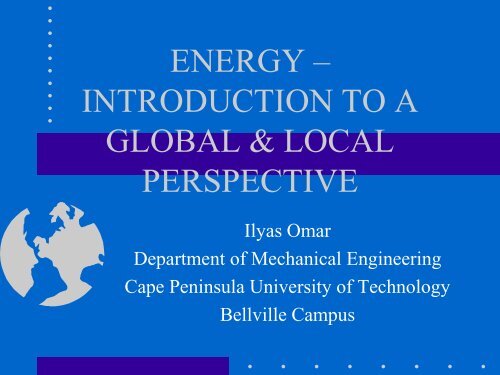ENERGY Environmental Engineering (MEV040) - DLIST Benguela
ENERGY Environmental Engineering (MEV040) - DLIST Benguela
ENERGY Environmental Engineering (MEV040) - DLIST Benguela
You also want an ePaper? Increase the reach of your titles
YUMPU automatically turns print PDFs into web optimized ePapers that Google loves.
Primary Global Energy• Change in sources of energy through history• 87% of world’s energy non-renewable(26.8% coal; 33.5% oil; 20.9% natural gas ;5.8% nuclear)• 13% renewable (biomass, solar, hydro,wind, geothermal, tidal - note LHP (>50MW) = 2.2%)
Global Energy Sample Data• 20% of world’s population use 70% of energy• OPEC (Saudi Arabia ~25%, Venezuela, Iran, etc.)has 75% of proven oil reserves• Russia & Middle East hold 75% of gas reserves• USA consumes ~25% of global energy; USA uses>twice amount of energy/capita than EU; 10 timesmore than African countries• 1,7 billion no access to electricity
Energy intensity (Wikipedia, 2011)
Resources & Reserves(Conservative Estimates)• Coal reserves 250 years• Oil until 2050• Natural gas until 2070• Non-renewables are declining, constant orshow marginal increases
Schematic of Resources &ReservesEconomicUneconomicDiscoveredResourcesUndiscoveredReserves
Non-Renewable Resources(Annual Increases - recent data)• Oil production rose 1,5%• Natural gas production up 0,5%• Coal use up 0,7%• Nuclear power steady (shutdowns in Holland,Germany, UK); although small scale underdevelopment (Toshiba 10 MW sodium-cooled, 30year refuelling, electromagnetic pumps; Nuscale45 MW, water coolant; PBMR?)
Reserves and resources – Hubbert Curve(Wikipedia, 2011)
Carbon emissions (Wikipedia, 2011)
Transition and future strategies• Resource shifts (20% renewable target by 2020 forEU – 50% global renewable by 2040)• <strong>Environmental</strong> taxes (CO 2 emissions) – EU 20%reduction by 2020 from 1990s levels• Energy efficiency (CFL exchange, SHW rebates)• South Africa 33.8 % electricity from RE by 2030(IRP 2010-2030)
Renewable Resources - Biomass• Rate of depletion < rate of generation =renewable• EU electricity potential = 1.5%• Combustion, gasification, pyrolysis,esterification, anaerobic digestion,bioethanol• 20% transport fuel in Brazil is bioethanol
Biogas digesters (Wikipedia, 2011)
Renewable Resources - Wind• Wind power growth accelerates 32% (2006) -74 GW installed• Spain, Germany, Italy, India, USA leaders• Can be used in wind farms as grid in-feed (80% ofDenmark’s electricity generation)• 62% of total renewable energy by 2010 inScotland• Darling wind 13 MW, Eskom Klipheuwel 3.2MW
Installed Wind Power (Wikipedia,2011)
Wind farm (Wikipedia, 2011)
Renewable Resources - PV• Solar cells (PV) production has increasedon average by 40% per year over the last 10years - production in 2004 was 1195 MWworldwide• Tamil Nadu (India) has 2040 MW ofrenewable electricity generation, 22% ofgrid capacity, and 55% of India’s totalrenewable output
PV water pumping (Lesotho)
PV water pumping site (SA)
PV modules (SA – NorthernCape)
Renewable Resources –Concentrated Solar Power (CSP)• Solar-thermal capacity 400 MW (2004)• No barriers to supplying 5% of globalelectricity by 2040 with CSP• 1 km 2 can generate the equivalent of a 50MW coal-fired power plant• 100 MW Eskom plant earmarked forUpington
Solar-thermal power (Wikipedia,2011)
Renewable Resources -Hydropower• LHP accounts for 4 % of global primary energy -18% of world electricity• 70% of technical potential in MDCs realised, only10% in LDCs• Large scale hydropower (LHP) can haveenvironmental consequences, fewer for SHP• China total SHP (
Hydro-electricity (Wikipedia,2011)
Supply - Load Profile(Wikipedia, 2011)
Pumped-Storage (Wikipedia, 2011)
Pumped-Storage Aerial View(Wikipedia, 2011)
Hydropower Examples
Primary Energy in SA• Coal accounts for 71.8% of primary energy• Oil = 14.1%• Natural gas = 1.3%• Nuclear = 2.7%• Hydro 0.1%• Solar/Wind 0.1%• Other renewables = 9.9% (largely biomass)
Electricity (SA)• 28% of population have no access - ruralconnections 52%• Coal produces 93% (6% nuclear, remainderrenewables)• Eskom 4th largest utility in the world• Produces > 50% of electricity in Africa• Capacity of over 40 GW - capacity exceeded in2008• Power stations (10 coal - 20 c/kWh, 2 gas turbine,2 hydro, 1 nuclear, 2 pumped storage, 2 OCGT –R2/kWh)
Energy Efficiency &Conservation (SA)• Improved efficiency - potential saving of10%-15% of current consumption• Discard coal - fluidised bed combustion(60% re-use; 4800 MW Medupi, Kusile)• Gas (cheaper~50%, high efficiency >50%,less space, reduced CO 2 ~50%, negligibleSO x ~99% , less NO x ~90%, less particulates)
Energy Efficiency &Conservation - SA (continued)• Buildings (passive solar design, insulation,solar water heating, lighting, appliances,landscaping)• Transport (multiple modes)• Heat recovery (e.g. Textiles = 40%; Paper& Pulp = 20% - co-generation)
New SHW Installations in SA (Dept.of Energy, 2011)
Barriers to energy efficiencyimprovements (SA)• high cost of capital• lack of awareness, information and skills• lack of access to efficient technologies• historically relatively low cost of electricity!• low cost of coal– latter two among lowest in the world
Strategies for SA• Resource shifts• Efficiency & conservation (e.g. 750 MWreduction with CFLs by 2010)• Renewable energy (IRP)• <strong>Environmental</strong> taxes (e.g. vehicle emissions tax)• Tax incentives & subsidies (e.g. Eskom SHWrebate)• Public transportation• Integrated energy planning












